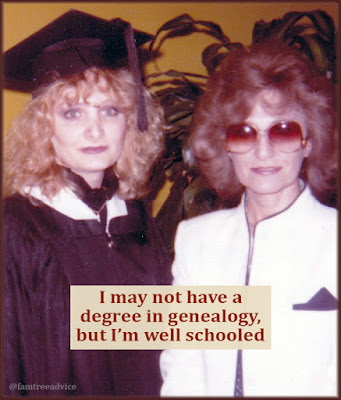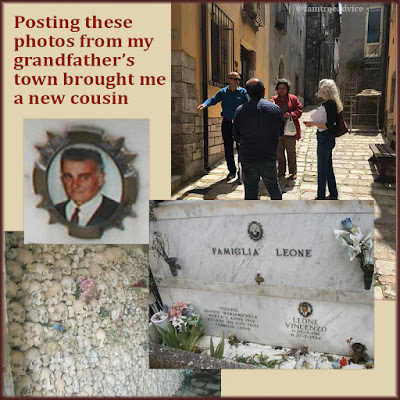Use this checklist of 7 tasks to scrub your family tree clean.
I want to help you make your family tree better and more professional. That's why I've been writing these genealogy articles twice a week for more than two years.
Today we'll look at 7 types of family tree clean-up tasks. Together they can improve your tree in so many ways.
1. Names
Does every name in your family tree meet your standards?
- Maiden names. It's a genealogy best-practice to record women using their maiden name. Let them have their own identity.
- Unknown names. When you haven't discovered someone's first or last name, consider recording it as _____. This makes it clear you haven't yet filled in that blank. Credit for this goes to Ancestry.com expert Crista Cowan. I used to use the word "Unknown", but a relative of mine misunderstood that. She said, "Oh, I'm sure she knew her name." I was stunned.
- Names only. Some people will record a person's name as Grandma Johnson, or Jane Dad's great aunt. If you put notes on people's names, you're not helping relatives and DNA matches to find you.
- More than one name. I insist on recording everyone's birth name. I'll add other names (nicknames, Anglicized names, and legal name changes) in the description field of a person's birth fact because it's a highly visible spot.
For more on this topic see This Genealogy Policy Takes the Guesswork Out of Names.
2. Places
Make sure the place names in your tree follow a consistent style. Family Tree Maker organizes your place names when they're written the right way. It's easy to click a country, then a state or province, then a town, and find a place. And with a click you'll see every name associated with a place.
For more on this topic see 3 Housekeeping Tasks for a Professional-Quality Family Tree and 4 Types of Family Tree Errors Only You Can Find.
 |
| Once I saw how nicely Family Tree Maker organizes place names, I cleaned them all up. |
3. Media Files
Remember when you first got started in genealogy? I know I was downloading census sheets and ship manifests as fast as I could find them.
All those media files need a facelift. And it will make them believable and valuable as evidence of your ancestor. Here's how I mark up each document image in my family tree:
- Write a caption. Start with a year to force media items to display in date order. Make it clear what each document is.
- Add the date. Documents will almost always have an exact date on them. Add this to the date field.
- Choose a category. Family Tree Maker lets me pick a category from their list, or add custom categories. Now I can sort my thousands of media files by type.
- Describe everything about the document image. I add enough information to allow myself or anyone else to find the original image again. That includes line numbers on the page, a description of the document collection, and a URL.
- Add a note. There is a notes tab for each media item in Family Tree Maker. You can type any information in there. Maybe you need to record who you wrote to to get this image.
For more on this topic see Add Proof and a Breadcrumb to Family Tree Documents, and How to Increase the Value of Your Family Tree Images.
4. Sources
I like to keep my sources simple. But I've been adding more and more detail to them.
I use a simple title, like "1900 U.S. Federal Census". A short title doesn't clutter up the person view in Family Tree Maker.
I copy the citation details and citation text from the collection. For example, for the 1900 U.S. Federal Census:
- The citation detail is:
Ancestry.com. 1900 United States Federal Census [database on-line]. Provo, UT, USA: Ancestry.com Operations Inc, 2004. - The citation text is:
United States of America, Bureau of the Census. Twelfth Census of the United States, 1900. Washington, D.C.: National Archives and Records Administration, 1900. T623, 1854 rolls. - The web address where you find those details and can search this collection is:
https://search.ancestry.com/search/db.aspx?dbid=7602
 |
| Having a neat, tight list of sources makes them easy to maintain and make better. |
I like that I can click any source in my tree and see every person and fact that's associated with it. I have a goal to get rid of secondary sources—like other people's trees. I need to replace them with primary sources. My source list makes it easy to find the facts I need to work on.
For more on this topic see 6 Easy Steps to Valuable Source Citations.
5. Filing
People seem to worry a lot about their document filing systems. Don't overthink it. Keep it simple and logical. Remember that you may pass your work on to a loved one some day.
What's logical to me is a folder for each main type of document:
- census
- draft cards
- ship manifests
- birth, marriage, and death certificates, etc.
I name my files, in general, LastnameFirstnameYear. Here are some of my file names:
- RignaneseMatteoNaturalization1944-p1.jpg
- CiottiMariaTeresaConcettaBirth1848.jpg
- CoccaAngeloAntonioMontaganoMariaBenedettaGenerosa1stMarriageBanns1833.jpg
- LucarelliGirolamoWW1.jpg
Because I follow a pattern, it's easy to see what a document is.
For more on this topic see 3 Rules for Naming Digital Genealogy Documents.
6. Backups
How fatal of a heart attack would you have if all your genealogy research disappeared?
Spread things out, but keep them at hand. Use your computer drive, external drives and cloud storage.
Make a backup plan for your genealogy files and stick to it. Remember that two backups are better than one. Many of my files synchronize to my cloud storage the moment they change. For everything else, I make a backup every Sunday morning. Without fail.
For more on this topic see 4 Ways to Protect Your Genealogy Research from Disaster.
7. To-Do Lists
It seems like everyone has their favorite way of keeping to-do lists. Post-It Notes, a special notebook, EverNote. I'm fond of keeping a single text file open on my computer all the time. It's called Notebook.txt. That's where I have my:
- Genealogy To-Do List
- 2019 Genealogy Goals List
- List of important families to work on
- List of files and folders to back up each Sunday
- and more
I don't care how you do it, but find a way to keep track of :
- what you want to do next
- what you were doing when you stopped for the day
- what you'd like to do when you have the chance.
For more on this topic see Start Your Rainy-Day Genealogy List.
That was a lot. And it's a lot of work. But chip away at these ideas and your family tree will grow stronger from your effort.
Make these tasks into a to-do list and tackle it one bite at a time. It's worth it.




